ONederlands Tijdschrift voor - Nederlands Tijdschrift voor Orthopaedie
ONederlands Tijdschrift voor - Nederlands Tijdschrift voor Orthopaedie
ONederlands Tijdschrift voor - Nederlands Tijdschrift voor Orthopaedie
Create successful ePaper yourself
Turn your PDF publications into a flip-book with our unique Google optimized e-Paper software.
Olivier A.J. van der Meijden, Henk van der Hoeven en Peter J. Millett ■van rupturering. Over het algemeen komt eenpatiënt in aanmerking <strong>voor</strong> operatief herstel alsde ruptuur meer dan 50% van dikte van de peesbeslaat (Ellman Graad III). 51 Naast primair herstelvan de partiële ruptuur is ook de zogenaamde ‘take-down’-procedure(peesherstel na eerst totaalmaken van een partiële ruptuur) succesvol beschreven.20,25,51,52 Een mogelijk <strong>voor</strong>deel van primairherstel van de partiële ruptuur is behoud van defootprint van de insertie van aangedane pees.Volgens deze criteria zijn de uitkomsten in patiëntenbehandeld met primair herstel significant beter invergelijking met patiënten die waren behandeldmet een debridement en SAD en zijn er uitkomstentot 100% tevredenheid van arthroscopisch primairherstel van ‘partiele articulaire supraspinatuspees avulsies’ (PASTA-laesies). 51,52 Tevens zijn <strong>voor</strong>zowel een open als arthroscopisch pees herstelna een ‘take down’-procedure na lange follow upgoede resultaten beschreven tot 93%. 25,53Op grond van de literatuur kan men adviseren omin geval van een ruptuur van minder dan 50% eendebridement te verrichten al of niet gecombineerdmet een acromioplastiek, afhankelijk van de locatievan de partiële laesie. Indien de ruptuur meer dan50% van de peesdikte beslaat wordt herstel van depees geadviseerd (Tabel 2). Het herstel van dezeprocedure is over het algemeen goed.Behandeling bovenhandse atletenNet als een afwijkende pathogenese is ook de behandelingvan partiële rupturen van de rotator cuffbij bovenhandse atleten anders in vergelijking met‘de gewone patiënt’. De focus van behandelingis gericht op preventie en maximale, aggressieveconservatieve therapie. 33,54-56 Indien er sprakeis van anatomische schade (labrum, cuff, capsulairedysfunctie) is de chirurgische behandelinggericht op herstel van het gelaedeerde weefsel(labrum repair, debridement cuff, kapselplastiek).Subacromiale decompressie wordt bij deze patiëntengroepsterk ontraden, aangezien het hier omeen secundair probleem. De resultaten van de chirurgischebehandeling bij bovenhandse atleten zijntot dusver niet bemoedigend, van zowel debridementmet acromioplastiek als primair herstel vande ruptuur. 54-56 Terugkeer naar sport is mogelijk<strong>voor</strong> de meerderheid, maar slechts de helft haaltminimaal het oude niveau. 54-56 Naarmate atletenouder worden en <strong>voor</strong>al als er sprake is van peesdegeneratie als gevolg van subacromiale of posterieureimpingement van de rotator cuff, daaltde kans op een succesvolle terugkeer naar debeoefende sport. 55 De postoperatieve begeleidingbij deze patiënten is van eminent belang om hetuiteindelijke resultaat te optimaliseren.AbstractThe glenohumeral joint is naturally an unstable articulation.A relevant portion of its static and dynamic stability is maintainedby the musculature of the rotator cuff. Pathology ofthe rotator cuff is the most frequent cause of shoulder painand increases with age. Though the incidence of rotator cufftearing increases with age, the exact incidence of partialcuff ruptures remains unknown with variations reportedto be between 11 and 30%. Partial tears most commonlyoccur in the supraspinatus tendon and can be divided intoarticular-sided, bursal-sided, or interstitial ruptures, or acombination of the above.The causes of partial cuff tears include intrinsic factors,such as tendonopathy and degeneration, and extrinsicfactors such as impingement, joint instability and trauma.Patients often present with non-specific symptoms of pain,weakness, or stiffness of the shoulder, which can overlapwith symptoms associated with subacromial bursitis, bicepstendinitis and even adhesive capsulitis.When a partial thickness tear is diagnosed, conservativetreatment is the first treatment of choice. When activity modificationsand restoration of range of motion and shoulderstrength have proven unsuccessful, surgical treatment maybe considered. In general, partial tears of less than 50% ofthe tendon thickness can be treated with arthroscopic debridement,in combination with acromioplasty, particularlyfor bursal-sided tears. Tears of more than 50% of tendonthickness are generally repaired, using an arthroscopictechnique. It is also important to determine the etiology ofthe partial cuff tear and treat any underlying causes.Literatuur1. Labriola, J.E., Lee, T.Q., Debski, R.E.McMahon, P.J.Stability and instability of the glenohumeral joint: therole of shoulder muscles. J Shoulder Elbow Surg. 2005.14(1 Suppl S): p. 32S-38S.2. Boykin, R.E., Millett, P.J. Rotator Cuff disease - basicsof dianosis and treatment. Rheumatology Reports. 2010.2(1).3. Lin, J.C., Weintraub, N.Aragaki, D.R. Nonsurgicaltreatment for rotator cuff injury in the elderly. J AmMed Dir Assoc. 2008. 9(9): p. 626-32.4. Braune, C., von Eisenhart-Rothe, R., Welsch, F., Teufel,M.Jaeger, A. Mid-term results and quantitative comparisonof postoperative shoulder function in traumatic andnon-traumatic rotator cuff tears. Arch Orthop TraumaSurg. 2003. 123(8): p. 419-24.5. Harryman, D.T., 2nd, Mack, L.A., Wang, K.Y., Jackins,S.E., Richardson, M.L.Matsen, F.A., 3rd Repairs of therotator cuff. Correlation of functional results withintegrity of the cuff. J Bone Joint Surg Am. 1991. 73(7):p. 982-9.6. Clark, J.M.,Harryman, D.T., 2nd Tendons, ligaments,and capsule of the rotator cuff. Gross and microscopicanatomy. J Bone Joint Surg Am. 1992. 74(5): p. 713-25.7. Dugas, J.R., Campbell, D.A., Warren, R.F., Robie,B.H.Millett, P.J. Anatomy and dimensions of rotator cuff insertions.J Shoulder Elbow Surg. 2002. 11(5): p. 498-503.Vol18dec’11<strong>Nederlands</strong> <strong>Tijdschrift</strong> <strong>voor</strong> <strong>Orthopaedie</strong>, Vol 18, Nr 4, december 2011 ■ 155


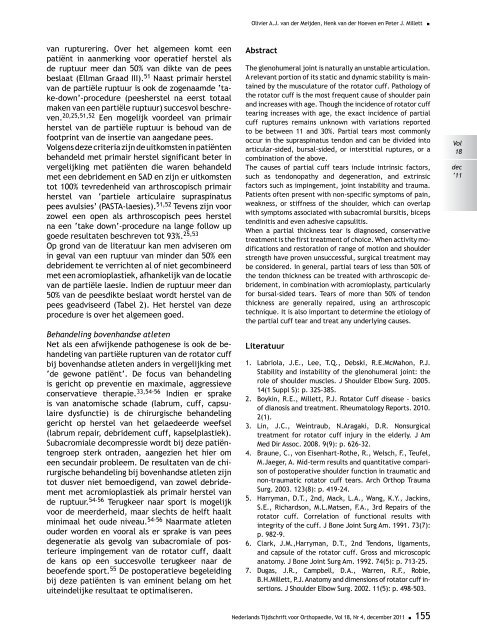
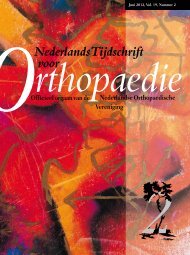

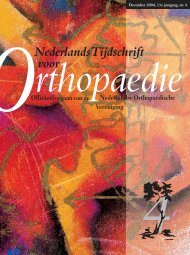


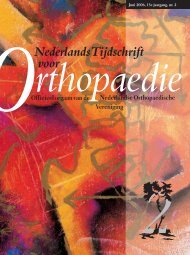
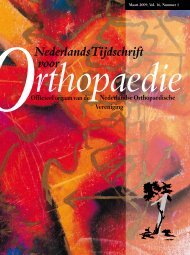

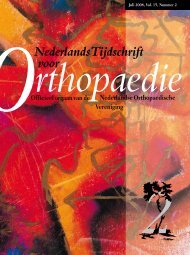
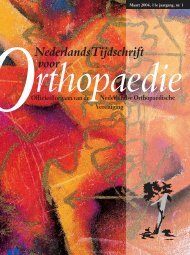



![NTvO OKT 2007 [ed_3].indd - Nederlands Tijdschrift voor Orthopaedie](https://img.yumpu.com/33045418/1/190x255/ntvo-okt-2007-ed-3indd-nederlands-tijdschrift-voor-orthopaedie.jpg?quality=85)